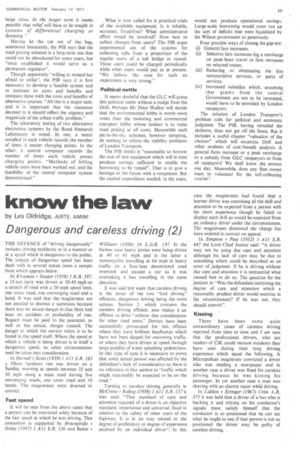know the law
Page 57

If you've noticed an error in this article please click here to report it so we can fix it.
by Les Oldridge, AIRTE, AMIM'
Dangerous and careless driving (2)
THE OFFENCE of "driving dangerously" includes driving recklessly or in a manner or at a speed which is dangerous to the public. The subject of dangerous speed has been dealt with in several stated cases a sample from which appears below.
In Kingman v Seager (1938) 1 K.B. 397, a 15-ton lorry was driven at 30-40 mph on a stretch of road with a 20 mph speed limit, one cross road, one converging road and a bend. It was said that the magistrates are not entitled to dismiss a summons because there was no actual danger in that there had been no accident or probability of one. Regard must be paid to the potential, as well as the actual, danger caused. The danger to which the section refers is to be found in the speed itself. Where the speed at which a vehicle is beingdriven is in itself a dangerous speed, no other circumstances need be taken into consideration.
In Darnell v Scott (1939) 1 All E.R. 183 a 50cwt furniture van was driven on a Sunday morning at speeds between 35 and 50 mph along a main road having five converging roads, one cross road and 10 bends. The magistrates were directed to convict.
Fast speed
It will be seen from the above cases that a person can be convicted solely because of the fast speed at which he was driving. This contention is supported by Bracegirdle v Oxley (1947) 1 All E.R. 126 and Baker v Williams (1956) 54 L.G.R, 197. In the former case heavy lorries were being driven at 40 to 45 mph and in the latter a motorcyclist travelling at 64 mph in heavy traffic on a four-lane derestricted road overtook and passed a car as it was overtaking a bus travelling in the same direction.
It was said last week that careless driving is the lesser of the two "bad driving" offences. dangerous driving being the more serious. Section 3. which contains the careless driving offence, also makes it an offence to drive -without due consideration for other road users." Drivers have been successfully prosecuted for this offence where they have brilliant headlamps which have not been dipped for oncoming traffic, or where they have driven at speed through large puddles of water splashing pedestrians. In this type of case it is necessary to prove that some actual person was affected by the defendant's lack of consideration as there is no reference in this section to "traffic which might reasonably he expected to be on the road."
Turning to careless driving generally in McCrone v Riding (1938) 1 All E.R. 157 it was said: "That standard of care and attention required of a driver is an objective standard, impersonal and universal, fixed in relation to the safety of other users of the highway. It is in no way related to the degree of proficiency or degree of experience attained by an individual driver". In this
case the magistrates had found that a learner driver was exercising all the skill and attention to be expected from a person with his short experience though he failed to display such skill as would be expected from an ordinary driver under the circumstances. The magistrates dismissed the charge but were ordered to convict on appeal.
In Simpson v Peal (1952) 1 All E.R. 447 the Lord Chief Justice said: "A driver may not be using due care and attention although his lack of care may be due to something which could be described as an error of judgment. If he is driving without due care and attention it is immaterial what caused him to do so. The question for the justices is: "Was the defendant exercising the degree of care and attention which a reasonably prudent driver would exercise in the circumstances? If he was not, they should convict".
Kissing
There have been some quite extraordinary cases of careless driving reported from time to time and I am sure that the professional drivers, who are readers of CM, could recount incidents they have seen during their long driving experience which equal the following. A Metropolitan magistrate convicted a driver who was reading a newspaper and in another case a driver was fined for careless driving because he was kissing his passenger. In yet another case a man was shaving with an electric razor while driving.
In Liddon v Stringer (1967) Crim. L.R. 371 it was held that a driver of a bus who is backing it and relying on his conductor's signals must satisfy himself that the conductor is so positioned that he can see what he ought to see; if that person is not so positioned the driver may be guilty of careless driving.
































































































